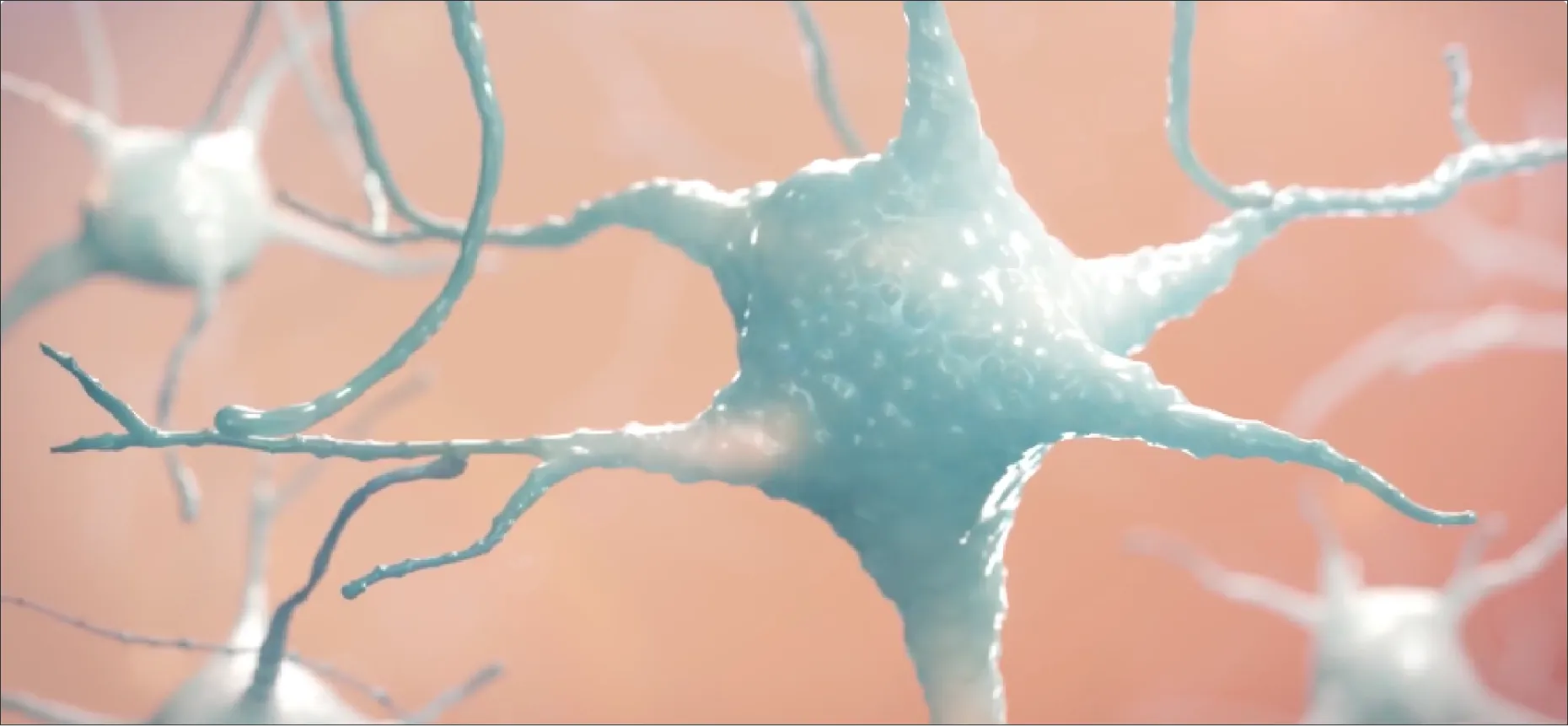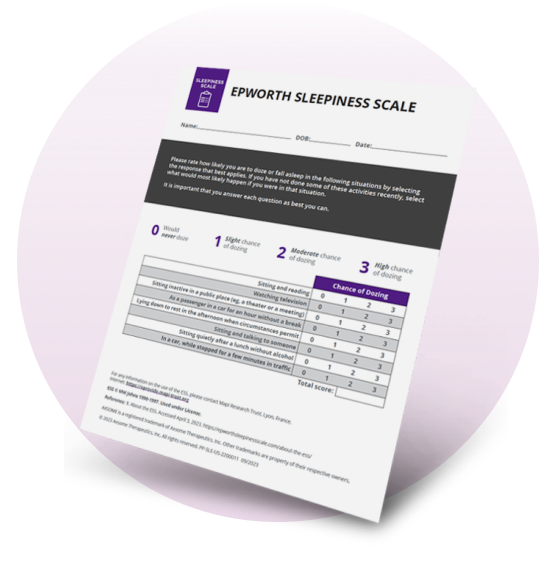Excessive daytime sleepiness (EDS) due to narcolepsy
EDS in narcolepsy may be due to a destabilization in sleep-wake balance neuronal activity1
In narcolepsy, sleep intrudes into wakefulness
Activation of the wake system suppresses the sleep system and vice versa, similar to an on-off switch.
This switch ensures stability between sleep and wakefulness.
Narcolepsy is a result of a dysfunction of the switch, causing sleep to intrude into wakefulness.
See how neurotransmitter dysregulation can affect the sleep-wake cycle

EDS in narcolepsy can be unpredictable2
Sleep can occur at any time and can last anywhere from a few seconds to several hours.
Patients may fall asleep about 3 to 5 times per day.
Sleep can occur in quiet, inert situations but can also occur during activities requiring mental or physical participation.
The American Academy of Sleep Medicine (AASM) recognizes that for some patients with narcolepsy, EDS “has significant detrimental impact.”3
–2007 AASM Practice Parameters for the Treatment of Narcolepsy and Other Hypersomnias of Central Origin
Assess your patients’ EDS with the Epworth Sleepiness Scale (ESS)4-6
A validated method to screen for, identify, and monitor EDS in narcolepsy

Identifying excessive daytime sleepiness
An ESS score of >10 indicates EDS5
The ESS is a validated, patient-reported measure of the patient’s likelihood of falling asleep during 8 daily activities, including reading, watching television, and driving5
Download the ESSThe Maintenance of Wakefulness Test (MWT)
Used in clinical and research settings to assess EDS in patients with narcolepsy7
The MWT is an objective measure that evaluates a patient’s ability to remain awake while8:
These 40-minute trials are repeated several times, separated by 2-hour breaks. Cumulative time equals total “wakefulness minutes.”
Four to five 40-minute trials, conducted over the course of 1 day
INDICATION AND IMPORTANT SAFETY INFORMATION
INDICATION
SUNOSI is indicated to improve wakefulness in adults with excessive daytime sleepiness (EDS) associated with narcolepsy or obstructive sleep apnea (OSA).
LIMITATIONS OF USE
SUNOSI is not indicated to treat the underlying obstruction in OSA. Ensure that the underlying airway obstruction is treated (e.g., with continuous positive airway pressure (CPAP)) for at least one month prior to initiating SUNOSI. SUNOSI is not a substitute for these modalities, and the treatment of the underlying airway obstruction should be continued.
IMPORTANT SAFETY INFORMATION
CONTRAINDICATIONS
SUNOSI is contraindicated in patients receiving concomitant treatment with monoamine oxidase inhibitors (MAOIs), or within 14 days following discontinuation of an MAOI, because of the risk of hypertensive reaction.
WARNINGS AND PRECAUTIONS
Blood Pressure and Heart Rate Increases
SUNOSI increases systolic blood pressure, diastolic blood pressure, and heart rate in a dose-dependent fashion.
Blood Pressure and Heart Rate Increases (Cont’d)
Epidemiological data show that chronic elevations in blood pressure increase the risk of major adverse cardiovascular events (MACE), including stroke, heart attack, and cardiovascular death. The magnitude of the increase in absolute risk is dependent on the increase in blood pressure and the underlying risk of MACE in the population being treated. Many patients with narcolepsy and OSA have multiple risk factors for MACE, including hypertension, diabetes, hyperlipidemia, and high body mass index (BMI).
Assess blood pressure and control hypertension before initiating treatment with SUNOSI. Monitor blood pressure regularly during treatment and treat new-onset hypertension and exacerbations of pre-existing hypertension. Exercise caution when treating patients at higher risk of MACE, particularly patients with known cardiovascular and cerebrovascular disease, pre-existing hypertension, and patients with advanced age. Use caution with other drugs that increase blood pressure and heart rate.
Periodically reassess the need for continued treatment with SUNOSI. If a patient experiences increases in blood pressure or heart rate that cannot be managed with dose reduction of SUNOSI or other appropriate medical intervention, consider discontinuation of SUNOSI.
Patients with moderate or severe renal impairment could be at a higher risk of increases in blood pressure and heart rate because of the prolonged half-life of SUNOSI.
Psychiatric Symptoms
Psychiatric adverse reactions have been observed in clinical trials with SUNOSI, including anxiety, insomnia, and irritability.
Exercise caution when treating patients with SUNOSI who have a history of psychosis or bipolar disorders, as SUNOSI has not been evaluated in these patients.
Patients with moderate or severe renal impairment may be at a higher risk of psychiatric symptoms because of the prolonged half-life of SUNOSI.
Observe SUNOSI patients for the possible emergence or exacerbation of psychiatric symptoms. Consider dose reduction or discontinuation of SUNOSI if psychiatric symptoms develop.
MOST COMMON ADVERSE REACTIONS
The most common adverse reactions (incidence ≥5%) reported more frequently with the use of SUNOSI than placebo in either narcolepsy or OSA were headache, nausea, decreased appetite, anxiety, and insomnia.
Dose-Dependent Adverse Reactions
In the 12-week placebo-controlled clinical trials that compared doses of 37.5 mg, 75 mg, and 150 mg/day of SUNOSI to placebo, the following adverse reactions were dose-related: headache, nausea, decreased appetite, anxiety, diarrhea, and dry mouth.
DRUG INTERACTIONS
Do not administer SUNOSI concomitantly with MAOIs or within 14 days after discontinuing MAOI treatment. Concomitant use of MAOIs and noradrenergic drugs may increase the risk of a hypertensive reaction. Potential outcomes include death, stroke, myocardial infarction, aortic dissection, ophthalmological complications, eclampsia, pulmonary edema, and renal failure.
Concomitant use of SUNOSI with other drugs that increase blood pressure and/or heart rate has not been evaluated, and combinations should be used with caution.
Dopaminergic drugs that increase levels of dopamine or that bind directly to dopamine receptors might result in pharmacodynamic interactions with SUNOSI. Interactions with dopaminergic drugs have not been evaluated with SUNOSI. Use caution when concomitantly administering dopaminergic drugs with SUNOSI.
USE IN SPECIFIC POPULATIONS
Renal Impairment
Dosage adjustment is not required for patients with mild renal impairment (eGFR 60-89 mL/min/1.73 m2). Dosage adjustment is recommended for patients with moderate to severe renal impairment (eGFR 15-59 mL/min/1.73 m2). SUNOSI is not recommended for patients with end stage renal disease (eGFR <15 mL/min/1.73 m2).
ABUSE
SUNOSI contains solriamfetol, a Schedule IV controlled substance. Carefully evaluate patients for a recent history of drug abuse, especially those with a history of stimulant or alcohol abuse, and follow such patients closely, observing them for signs of misuse or abuse of SUNOSI (e.g., drug-seeking behavior).
SUN HCP ISI 05/2022
Please see full Prescribing Information.
REFERENCES:
- Schwartz JRL, Roth T. Neurophysiology of sleep and wakefulness: basic science and clinical implications. Curr Neuropharmacol. 2008;6(4):367-378.
- Ahmed I, Thorpy M. Clinical features, diagnosis and treatment of narcolepsy. Clin Chest Med. 2010;31(2):371-381.
- Morgenthaler TI, Kapur VK, Brown T, et al; Standards of Practice Committee of the American Academy of Sleep Medicine. Practice parameters for the treatment of narcolepsy and other hypersomnias of central origin. Sleep. 2007;30(12):1705-1711.
- Ahmed IM, Thorpy MJ. Clinical evaluation of the patient with excessive sleepiness. In: Thorpy MJ, Billiard M, eds. Sleepiness: Causes, Consequences and Treatment. Cambridge University Press; 2011:36-49.
- Johns MW. About the ESS. The Epworth Sleepiness Scale. Accessed January 10, 2025. https://epworthsleepinessscale.com/about-the-ess/
- Johns M, Hocking B. Daytime sleepiness and sleep habits of Australian workers. Sleep. 1997;20(10):844-849.
- Arand D, Bonnet M, Hurwitz T, Mitler M, Rosa R, Sangal RB. The clinical use of the MSLT and MWT. Sleep. 2005;28(1):123-144.
- SUNOSI (solriamfetol) [prescribing information]. New York, NY: Axsome Therapeutics, Inc.
- Franco-Pérez J, Ballesteros-Zebadúa P, Custodio V, Paz C. Principales neurotransmisores involucrados en la regulación del ciclo sueño-vigilia [Major neurotransmitters involved in the regulation of sleep-wake cycle]. Rev Invest Clín. 2012;64(2):182-191.
- Saper CB, Scammell TE, Lu J. Hypothalamic regulation of sleep and circadian rhythms. Nature. 2005;437(7063):1257-1263.
- American Academy of Sleep Medicine. International Classification of Sleep Disorders. 3rd ed. American Academy of Sleep Medicine; 2014.


